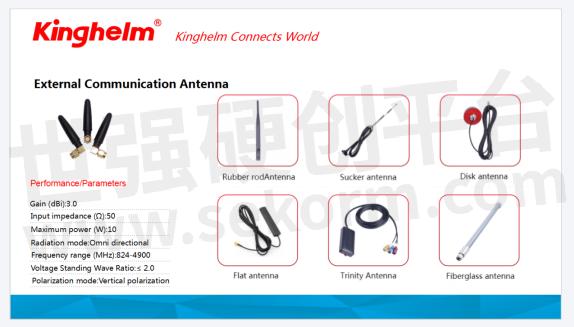A Comprehensive Guide of How to Choose Antennas for Routers





In today's digital age, a reliable internet connection is crucial for both personal and professional activities. One of the key components that can significantly enhance your Wi-Fi signal strength and coverage is the router's antenna. Choosing the right Antennas for your router can make a world of difference in your internet experience. This article will guide you through the factors to consider when selecting antennas for your router, including a focus on Kinghelm antennas, ensuring optimal performance for your home or office network.
Understanding Router Antennas
Routers typically come with either internal or external antennas. Internal antennas are built into the device and are usually less powerful, while external antennas can be adjusted and often provide better range and signal strength. Some routers allow users to replace or upgrade their antennas, making it essential to know what to look for.
Factors to Consider When Choosing Antennas
1. Antenna Type
There are two main types of antennas: omnidirectional and directional.
● Omnidirectional Antennas: These antennas radiate signals in all directions, making them ideal for covering a large area. They are suitable for home use, where you want a strong signal in multiple rooms.
● Directional Antennas: These antennas focus the signal in a specific direction, providing a stronger signal in that area. They are perfect for targeting a specific location, such as a home office or backyard.
2. Gain Measurement
Antenna gain is measured in decibels (dBi). A higher gain indicates a stronger signal and better range. Here’s a quick breakdown:
● Low Gain (0-3 dBi): Suitable for small areas, ideal for omnidirectional antennas.
● Medium Gain (4-8 dBi): Good for average home or office setups.
● High Gain (9 dBi and above): Best for long-range applications and targeted coverage.
Choose the gain based on your coverage needs. If you have a large area to cover, consider antennas with higher gain.
3. Frequency Bands
Modern routers operate on two frequency bands: 2.4 GHz and 5 GHz. Each band has its own characteristics:
● 2.4 GHz: Offers longer range but slower speeds. It’s more prone to interference from other devices.
● 5 GHz: Provides faster speeds but has a shorter range. It’s less congested and ideal for high-speed internet usage.
When choosing antennas, ensure they support both bands for optimal performance.
4. Connector Type
Not all antennas are compatible with every router. Check the connector type on your router (common types include RP-SMA and N-type) to ensure compatibility with the antennas you’re considering. If you're unsure, consult your router’s manual or the manufacturer's website.
5. Antenna Length and Design
The physical length and design of the antenna can also affect performance. Longer antennas typically provide better range. Additionally, consider whether you want adjustable antennas for flexibility in positioning or fixed antennas for a more streamlined look.
Choosing Kinghelm Antennas
Kinghelm antennas are known for their reliability and performance. Here are some reasons to consider them:
● High Gain Options: Kinghelm offers antennas with various gain levels, making it easy to find the right one for your coverage needs. Look for models with higher dBi ratings for extended range.
● Dual-Band Compatibility: Many Kinghelm antennas support both 2.4 GHz and 5 GHz frequencies, ensuring you can take full advantage of your router’s capabilities.
● Durable Design: Kinghelm antennas are built to withstand various environmental conditions, making them suitable for both indoor and outdoor use.
● Easy Installation: Most Kinghelm antennas come with straightforward installation instructions, allowing you to upgrade your setup quickly and efficiently.
Installation Tips
Once you’ve chosen the right antennas, installation is straightforward. Follow these steps:
1. Power Off the Router: Always turn off your router before replacing the antennas to prevent any damage.
2. Remove Old Antennas: Unscrew the existing antennas gently.
3. Attach New Antennas: Screw in the new Kinghelm antennas securely, ensuring they are connected properly.
4. Positioning: Adjust the antennas to optimize signal direction, especially for directional antennas.
5. Test the Connection: Power on your router and test the Wi-Fi signal strength in various areas of your home or office.
Conclusion
Choosing the right antennas for your router can significantly enhance your internet experience. By considering factors such as antenna type, gain, frequency bands, connector types, and design—especially when exploring options like Kinghelm antennas—you can find the perfect fit for your needs. With the right antennas in place, you’ll enjoy improved signal strength, better coverage, and a faster, more reliable connection for all your devices.
Investing time in selecting the right antennas is a small but impactful step towards optimizing your home or office network. Happy surfing!
- |
- +1 赞 0
- 收藏
- 评论 0
本文由雪飘梦飞转载自Kinghelm Official Website,原文标题为:How to Choose Antennas for Routers: A Comprehensive Guide,本站所有转载文章系出于传递更多信息之目的,且明确注明来源,不希望被转载的媒体或个人可与我们联系,我们将立即进行删除处理。
相关推荐
Improving Stability of Rubber Stick Antennas with Balanced Feeding Design for Better Performance
Let’s take a 433MHz, 20cm foldable rubber stick antenna as an example to explore the benefits of a balanced feeding design.
How Far Does An Industrial Router‘s Coverage Reach? Strategies to Enhance Signal Coverage
The coverage range of industrial routers is influenced by various factors, but through optimizing router placement, utilizing high-gain antennas, deploying repeaters, establishing mesh networks, selecting optimal channels, and upgrading communication technologies, we can effectively enhance their signal coverage, ensuring the stable operation of Industrial Internet of Things networks.
4g Lte Router How to Bridge Another Router: Deep Analysis and Application Practice
In the vast field of Industrial Internet of Things (IIoT), network stability and scalability are key factors for enterprises to pursue efficient and intelligent production. With the increasing complexity of industrial networks, the coverage and capabilities of a single router often struggle to meet the demands of large-scale, multi node production environments. Therefore, mastering 4g lte router bridging technology has become one of the essential advanced skills for industrial IoT engineers.
Delta lndustrial Ethernet
型号- DVS,DVS-328 SERIES,DVW,DVS-016,DVS-G406W01-2GF,DVS-G402R00-INJ,DVS-G002I00C-TF SERIES,DVS-008 SERIES,LCP-100SMF60T,DVS-G106W02-2GF,DVS-008W01,DVS-005W01,DVS-109W02-1GE,DVS-005I00 SERIES,CLIQ SERIES,DVS-103I02C-DLR,LCP-100MMFT,DVS-G112 SERIES,DVS-G928W01,DVS-016W01-SC01,DVS-109 SERIES,DX-3001H9,DVS-300,LCP-GBE SERIES,DVS-G008W01,DVS-008W,DX-2100RW-CN,DVS SERIES,DVW SERIES,DVS-008W SERIES,DVS-G112W02-4GF,CLIQII,DVS-G928 SERIES,DVS-008R00,DVW-W02W2-E2,DVS-016 SERIES,CLIQII SERIES,LCP-100SMF30T,LCP-100MMF,DVW-ANTRM8N-B3,DVS-G900-4GF,DVS-G900-6GM12,DVS-G900-8GE,AH500 SERIES,DVS-108W02-2SFP,DVS-G116W02-4GF,DVS-005W,DVS-005R00,DVS-G005I00C,DVW-ANTRM8N-B3 SERIES,DVS-G900-8GF,LCP-100SMF60,DVS-G005I00A,DVS-G116 SERIES,DVS-103I02C-DLR SERIES,DVS-G512W01-4GF,DVW-W01I2-E1-EU,DVS-328,DVW-W01I2-E1 SERIES,DVS-G402R00-INJ SERIES,DX-2300 SERIES,DVS-G401 SERIES,DVS-G008W01-KR,DX-2300LN-CN,DVP-SE,DVW-W01I2-E1,CLIQ,LCP-1000LX10T,LCP-1000SXT,DVW-W02W2-E2-CN,DX-3001H9-V,DVS-G928W01-CN,DX-2300,DVS-008W00-M12,LCP-1000SX,DVS-016W01-MC01,DVS-G928,DVW-ANTRM7G-B3 SERIES,DVS-G408,DVS-G401R00-SPL SERIES,DVS-005W01-SC01,DVS-G512W01-4GF SERIES,DVS-G408W01,DVS-008W01-MC02,DVS-008W01-MC01,DVS-G008W01 SERIES,LCP-1000LX10,IFD9506,DVS-016W SERIES,DVS-005I00,DVS-109,DVS-108,DVS-G406 SERIES,DVW-W01I2-E1-CN,DVS-300 SERIES,DVW-W02W2-E2 SERIES,DVS-005W01-MC01,DVS-008I00 SERIES,DVS-G402 SERIES,DVS-100,DVS-G005I00A SERIES,DVS-G408 SERIES,DVS-G400 SERIES,DVS-G002 SERIES,DVS-G005I00C SERIES,DVS-G002,DVS-016W,PMC SERIES,LCP-1FE,DX-3021L9 SERIES,LCP-100SMF30,DVS-G406,DVS-110 SERIES,AS300,DVS-G400,DVS-008I00,LCP-GBE,DVW-W02W2-E2-EU,DX-2100 SERIES,DX-2100RW-WW,DVS-G402,LCP-1000LHX40,DVS-G401,DVS-016W01,DVS-110,DVS-008W00-M12 SERIES,DX-3001H9-V SERIES,DVS-G112,DVS-G002I00C-TF,DVW-ANTRM7G-B3,AH500,DVS-G401R00-SPL,DVS-G116,DVS-G512,DVS-008W01-SC02,DVS-G406W01-2GF SERIES,DX-3001H9 SERIES,DVS-008W01-SC01,LCP-1000LHX40T,DVS-008,LCP-1FE SERIES,DVS-G106 SERIES,DVS-108 SERIES,PMC,DX-2300LN-WW,DVS-005W SERIES,DVS-100 SERIES,DX-3021L9,DVP SERIES,DVS-005R00 SERIES,DVS-G408W01 SERIES,DVS-G106,DVS-008R00 SERIES,DVS-328R02-8SFP,DX-2100,DVS-110W02-3SFP,DVP-SE SERIES,DVP,DVS-G512 SERIES
Wireless Antennas: Principles of Signal Transmission
Wireless communication technology is an integral part of modern life. This article explores the fundamental principles of how antennas transmit signals, diving into the physics behind the process.Future antennas are expected to be more compact, precise, and efficient, enabling faster, more reliable, and longer-range communication systems.
Ceramic Antennas: Principles, Characteristics, and Their Applications in Wireless Communication
Ceramic antennas, as essential components in the field of wireless communication, have garnered widespread attention due to their unique performance characteristics and extensive application areas.
Introduction to the Principles of Fiberglass Antenna
Fiberglass antenna is a lightweight and high-strength antenna widely used in wireless communication, broadcasting, aerospace, and other fields. This article will introduce the working principle and advantages of fiberglass antennas.
Wireless Antenna Transmission Principles and Structure
In this article Kinghelm will introduce the transmission principles of wireless antennas, exploring how antennas transform current signals into radio waves and explaining the fundamental physical processes involved.
Kinghelm USB Type-A Female Connector KH-2AF180ZJ-17: Your Solution for Seamless Digital Connectivity
KH-2AF180ZJ-17 USB Type-A to Type-A connector by Kinghelm offers reliable connectivity for data transfer and charging needs. With its premium materials, robust performance, and adaptability to different environments, it is an optimal choice for seamless and efficient digital experiences in various settings.
Kinghelm KH-SMA-K513-G RF Board Sockets Achieve Curved Connection and Are Suitable For Small Space Occasions
The parameter advantage of KH-SMA-K513-G lies in its inner hole bent head design, which can achieve curved connection and is suitable for small space occasions. Its impedance is 50Ω, and the maximum frequency is 6GHz, which can meet the needs of high-frequency transmission.
What are the Three Common Connectors?
Connectors are essential components in various electronic systems, enabling the transfer of power, data, and signals between different devices. Whether in consumer electronics, industrial machinery, or automotive applications, connectors ensure reliable connections and efficient system operation. In this article, we will explore the three most common types of connectors used in electronics: USB connectors, HDMI connectors, and SMA connectors.
Mr. Song Shiqiang,a Chief of Kinghelm and Slkor,Takes You to Witness the Global Restructuring of the Electronics Industry Chain
Kinghelm continues to explore microwave RF transmission and reception technologies, keeping pace with the trends of the “Internet of Everything“ era and the evolving societal landscape.
The Visual Propaganda Matrix of “kinghelm Connects World“ Has Undergone An Iterative Upgrade, Accelerating The Implementation of Its Internationalization Strategy
“Kinghelm“ and “Slkor“ have developed into internationally renowned brands. These two companies have collaborated extensively in exploring and researching internet communication and promotion.
Kinghelm, A Leading Manufacturer in The Field of Micro Signal Connectors and Plug Components, Has Gained Widespread Popularity in The European and American Markets
Kinghelm‘s products have been well received by customers in Europe, America, and other countries and regions. They currently serve over 10,000 customers worldwide.
电子商城
现货市场





































































































































































































登录 | 立即注册
提交评论